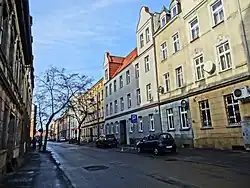 Street view westward | |
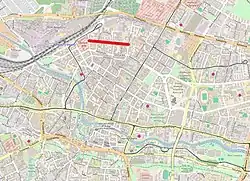 Bocianowo street highlighted on a map | |
| Native name | Ulica Bocianowo w Bydgoszczy (Polish) |
|---|---|
| Former name(s) | Brenkenhoff Straße |
| Part of | Bocianowo district |
| Namesake | District name |
| Owner | City of Bydgoszcz |
| Length | 600 m (2,000 ft) |
| Width | c. 10 metres (33 ft) |
| Location | Bydgoszcz, |
| Coordinates | 53°08′06″N 18°00′10″E / 53.13500°N 18.00278°E |
| Construction | |
| Construction start | Late 1870s[1] |
Bocianowo Street is a 600 metres (2,000 ft) long path in the northern part of Bydgoszcz city. Its facades display various architectural styles and its history sticks with the end-of-19th-century development of the town.
Location
Located in the Bocianowo district, the street is laid on an east-west axis, from Pomorska street to Sowińskiego street.
On its path, the thoroughfare crosses the following streets:
- Kaszubska;
- Henryka Sienkiewicza;
- Racławicka;
- Rycerska;
- Żółkiewskiego.
Bocianowo refers to the name of the district. The latter comes from the farming domain established in the area:[2] Bocian means Stork in Polish.
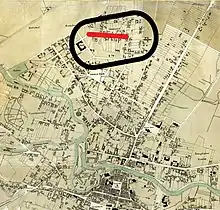
History
Until the beginning of the 19th century, the Brenkenhoff farm or "folwark" was settled in the place of the present district. In 1851, the area was incorporated into the territory of then Bromberg city.[3]
In 1867, the construction of the railway to Toruń required the purchase of part of the Brenkenhoff/Bocianowo estate; the line is no more existent today. At that time were laid out Bocianowo street (then "Brenkenhoff straße"), as well as Sienkiewicza street ("Mittel straße"), Rycerska street ("Wörth straße") and Racławicka street ("Ritter straße"). They were mainly the abode of railway workers.[2]
The path of Bocianowo street can be traced back to a 1876 city map, where the axis is underlined in the northern area of "Brenkenhoff".
Main areas and edifices
Tenement at 1, corner with 71 Pomorska Street
1894–1895[4]
Initial address was Verlängerte Rinkauerstraße 7 or Verlängerte Brenkenhoff Straße 7 and it was first owned by Franziska Kowalkowska, a widow. David Kukuk ran the distillery on the ground floor in the 1910s. The Kowalkowski family lived in the tenement till the turn of the 20th century.[5]
The elevations have been restored in 2021.[6] One can make out cartouches, the tympanum above the gate and the pediments of the first floor bearing the initial "K", recalling the first landlord, "Kowalkowski".
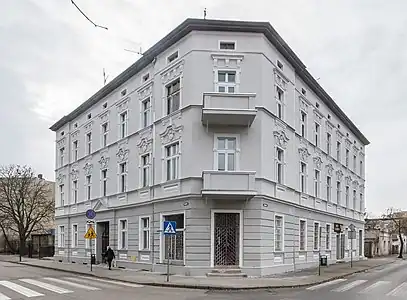 Renovated building, corner view
Renovated building, corner view Pediment detail with the "K" initial, before refurbishment
Pediment detail with the "K" initial, before refurbishment The tenement in the 1910s
The tenement in the 1910s
Tadeusz Kościuszko Square
In the beginning of the 19th century, a cemetery was located on this plot. Historically, this comes from a city's privilege until 1811 to bury the dead in random squares and squares.[3]
The square, delimited by Bocianowo and Pomorska streets, bears since 1973, the sculpture Wings of the Sea (Polish: Skrzydła morza), by Anna Szalast. The monument celebrates the industrial heritage of Bydgoszcz. It echoes in particular the nearby presence of the factory "FAMOR" at Kaszubska street.[7]
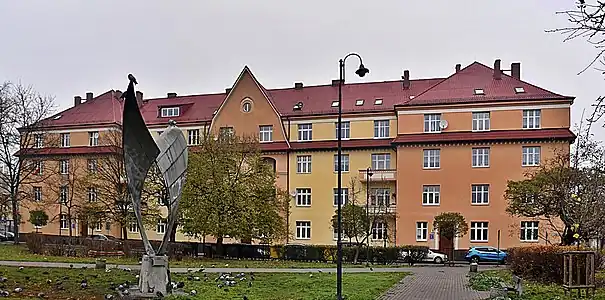 View of Tadeusz Kosciuszko square
View of Tadeusz Kosciuszko square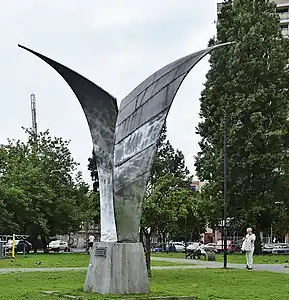 Sculpture "Wings of the Sea"
Sculpture "Wings of the Sea"
Buildings at 6 and 8
1950s[8]
The plots have been used as gardens (Polish: ogród) till the 1950s.[9]
The tenement at 6 has been renovated in 2021, Nr.8 is being renovated in 2022.[8]
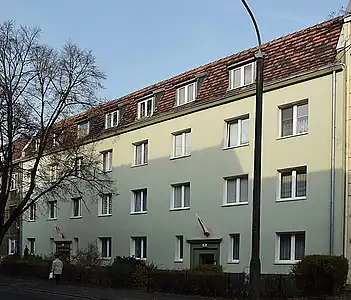 Facade at 6 Bocianowo
Facade at 6 Bocianowo
Tenement at 11
1901[4]
Early Modernism
The current building came after a previous edifice that has been standing here since the late 1890s.[10] It has been first owned by Wilhelm Schüler, declared as a locksmith.[11]
The tenement has been restored in 2021-2022,[6] highlighting many architectural details: stuccoed motifs, festoons and a lavishly adorned portal with a plastered transom.
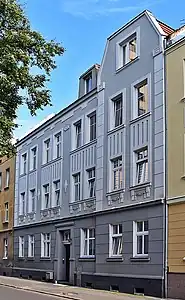 Elevation at 11
Elevation at 11
Tenement at 13
1898[4]
Initially at 48 Brenkenhofs Straße, the building's landlord was Mr and Mrs Kolbe, working as restaurateurs.[12]
Renovated in 2022, the tenement displays Art Nouveau style motifs and floral stuccos. The decoration around the entrance portal is particularly noticeable, as well as the wooden large door.
 Facade at 13 Bocianowo
Facade at 13 Bocianowo Entrance portal at 13
Entrance portal at 13
Tenement at 14, corner Racławiska Street
Late 1890s[10]
Cäsar Klettke, a butcher, owned this edifice from the end of the 19th century till the re-birth of Poland in 1920.[10] He was living in the nearby house at today's Nr.21.
The elevations exhibit eclectic style, leaning on neo-classicist features.
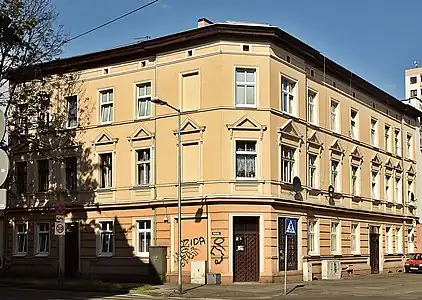 Corner view
Corner view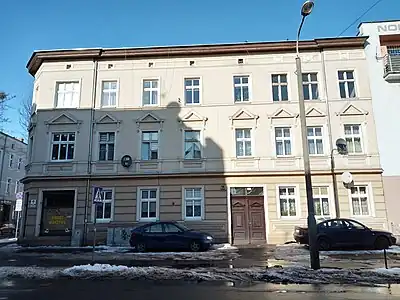 Facade on Bocianowo street
Facade on Bocianowo street
Building at 60 Sienkiewicza Street, corner with Bocianowo street
Late 1890s[13]
This long corner house was first owned by Johann ßalmowski, a baker.[13] Today, a bakery still operates here: it is specialised in potato bread made with rye flour.
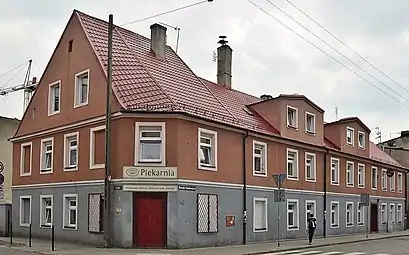 View of the corner house at 60 Sienkiewicza
View of the corner house at 60 Sienkiewicza
House at 61 Sienkiewicza Street, corner with Bocianowo street
Late 1890s[13]
This building was an investment of the Brothers Hobberg: Wilhelm funded the edifice at 61 (Robert the one at 59). Wilhelm was a master carpenter.[13]
The facades at Nr.61, on the corner with Bocianowo street, have unfortunately lost all their decoration.
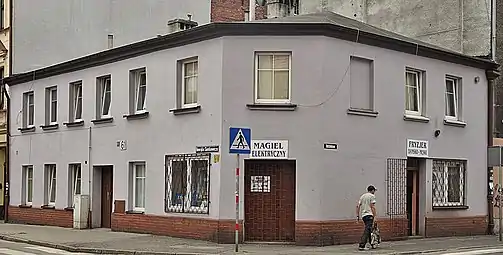 Corner house at 61
Corner house at 61
Tenement at 1 Racławiska Street, corner with Bocianowo street
Early 1880s, 1905[14]
This tenement, originally at 1 Wörth Straße, was the property of Julius Hanke;[14] in 1890, Ferdinand Klatte purchased it[15] and kept it till the turn of the 20th century.[16]
The facades display few elements save for Art Nouveau adornment of the openings (stuccoed woman faces, vegetal motifs and festoons).
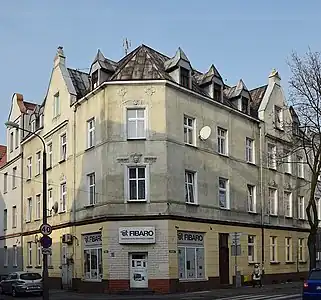 View from street intersection
View from street intersection
Tenement at 16
1909-1910[4]
First landlord was Julius Schepull, an iron lathe operator.[17] The 1910 address book mentions the building as new (German: Neubau).
The edifice lost all its Art Nouveau details and only kept its overall design with two ogee shaped wall gables.
 Main frontage
Main frontage
Tenements at 19 and 22/22a
1910-1911[4] (No19) 1907-1908[4] (No22/22a)
At the time of its construction, Nr.19 building was located at "33 Mittelstraße" (present day Sienkiewicza Street): its owner Friedrich Hohberg was running there a shop selling colonial goods (German: Kolonialwaren) and drugs.[11] Nr.22/22a'sfirst owner was Julius Ischler.[17]
Although worn, Nr.19 facade showcases a grand bay window topped by a terrace and a large ogee shaped wall gable. At Nr.22/22a, only remains a large Art Nouveau wooden entrance door.
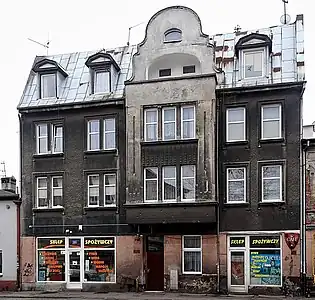 Nr.19 elevation on the street
Nr.19 elevation on the street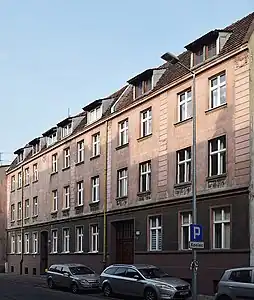 Frontage at 22/22a
Frontage at 22/22a
Tenement at 21
Late 1886[4]
Cäsar Klettke, a butcher, owned this building from the mid-1880s till 1910.[17] In 1899, he also purchased another tenement in the street, at today's Nr.14.[10]
The one-storey edifice is pretty worn out. One can still make out places for cartouches and the plastered decoration of window jambs and lintels.
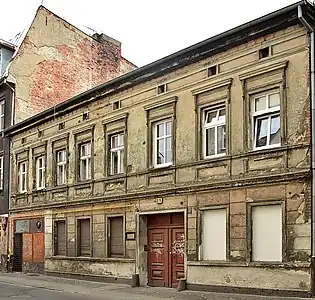 Main frontage
Main frontage
Tenement at 23
1907-1908[4]
The building has the specificity to have been funded by the Prussian state railways at the start of the 20th century,[18] housing railway workers from the neighbouring rail lines and stations. After the re-cration of the Polish state, the tenement briefly moved into the hands of the State Treasury (Polish: Dom Skarbowy)[19] before coming back to the ownership of the Polish State Railways.[9]
 Elevation from the street
Elevation from the street
Tenement at 24 and mural
1895-1896[4]
Initial address was 26 Brenkenhoff Straße, the first landlord being Carl Görke, a railtransport brakeman.[20]
The elevation presents nice details, from the bossage on the ground floor, to the adorned pedimented windows to the corbel table running on the top.
The side wall of the building has been embellished since 2012 by a mural called "Miś" (English: Bear). It was designed by Bartosz Bujanowski from Bydgoszcz and Łuksza Berżer from Wrocław as the result of street art classes attended by local children and adolescents.[21]
 Main frontage
Main frontage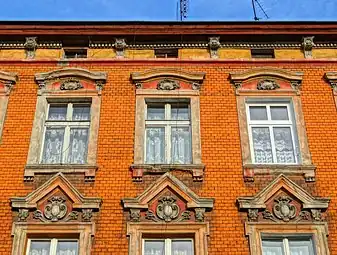 Detail of the facade decoration
Detail of the facade decoration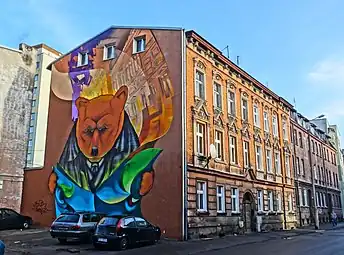 View of the side mural
View of the side mural
Tenement at 27
Late 1895-1896[4]
The building was commissionned by Gottfried Scholz.[20]
Very few details from the eclectic facade remain, apart from the stuccos of the window jambs and lintels.
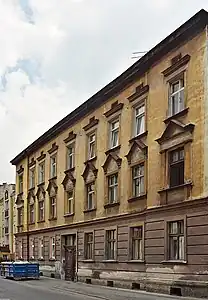 Facade at Nr.27
Facade at Nr.27
Tenement at 29
1913-1915[4]
Late Art Nouveau
The first registered owner was Carl Thiede, a butcher.[12]
The facade is progressively losing its Art Nouveau features by lack of renovation. One can discern floral motifs flanking the entrance door as well as shape vegetal designs in cartouches on the bottom of both bay windows.
 Elevation on the street
Elevation on the street
Tenement at 30 and 32 (corner with Rycerska street)
Carl Hofmann, a restaurateur, was the first landlord of these buildings. At that time (1905) he also owned abutting tenement at Nr.28 where he lived.[22]
The main frontage of Nr.30 is arguably one of the best preserved in the street. Art Nouveau motifs are not only present all over the curved wooden front door, but also on the balcony, the bay windows, around the windows and on the top of the facade.
The tenement at Nr.32 is most noticeable by its dramatic corner bay window similar to a bartizan, crowned by an onion dome roof, reminding of similar buildings in Bydgoszcz (e.g. at 8 and 27 Swiętej Trojcy Street or at 1 Plac Wolności). It was restored in 2021.[6]
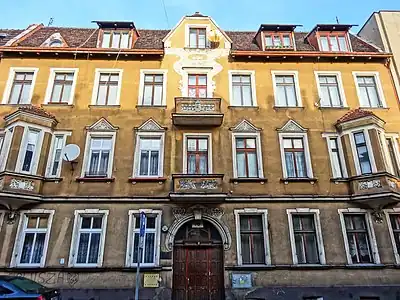 Main frontage of Nr.30
Main frontage of Nr.30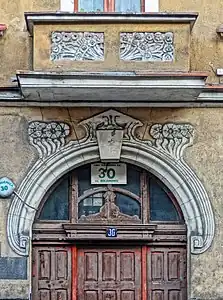 Portal details (Nr.30)
Portal details (Nr.30) Top facade (Nr.30)
Top facade (Nr.30)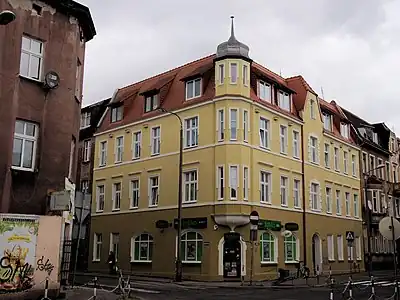 Corner tenement at Nr.32
Corner tenement at Nr.32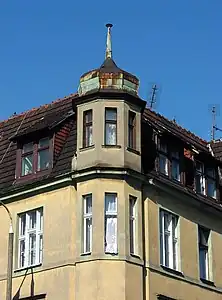 Detail of the onion dome at Nr.32
Detail of the onion dome at Nr.32
Wierus tenement at 33
Early 1880s[14]
Wilhelm Wierus, a stone mason, commissionned the building in 1880[14] and kept it till the mid-1930s.[9]
The tenement, renovated in 2021,[23] displays superb architectural details.
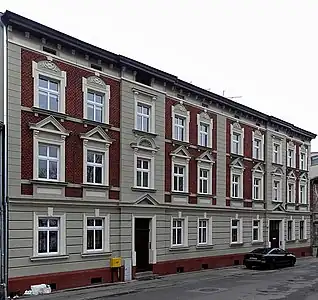 Refurbished frontage
Refurbished frontage
Tenement at 34, corner with Rycerska street
1893[24]
This building, at then "21 Brenkenhoff Straße", had Eduard Mäßing, a beer and food merchant, as owner.[24]
Both facades have unfortunately lost all their features with time.
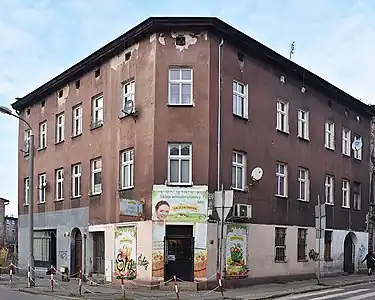 View from street corner
View from street corner
Radtke tenement, at 35
1890-1891 and 1904,[4] by Anton Hoffmann[25]
Ferdinand Radtke commissionned this building in the early 1890s to architect Anton Hoffmann. Radtke worked as a teacher at Adlershorst, a close suburban town south west of then Bromberg and lived in "Schulstraße" (today Dąbrowskiego street in Szwederowo district.[15] The ensemble was modernized at the turn of the 20th century with Art Nouveau features.
The edifice has been deeply restored in 2021.[6] One can now appreciate the balanced facade from the eclectic period (end of 19th century) mixed with plastered Art Nouveau motifs adorning the elevation gable.
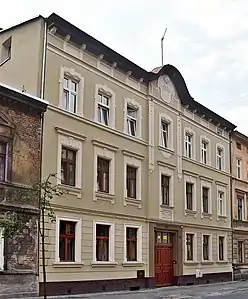 Renovated facade
Renovated facade Stucco detail
Stucco detail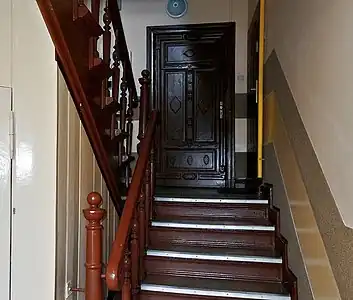 Staircase
Staircase
Tenements at 37, 38 and 40
1902[4] (37) 1896[26] (38) 1897[27] (40)
Johann Domeracki, a journeyman, was the owner of the tenement at 37.[28] Friedrich Greinert, a railway worker, owned Nr.38.[26] Friedrich Engwer, an accountant, was the landlord of Nr.40.
- No specific architectural details survived on the facade of 37.
- Nr.38 has seen only its ground floor renovated: it underlines the half-moon transom entrance door topped with a bearded figure.
- N.40 has been restored in the 2010s and present nice eclectic features.
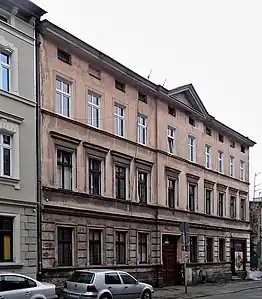 Main elevation at 37
Main elevation at 37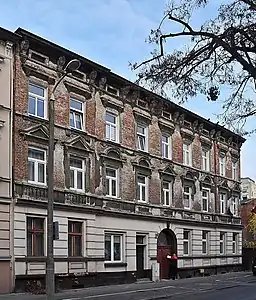 Frontage at 38
Frontage at 38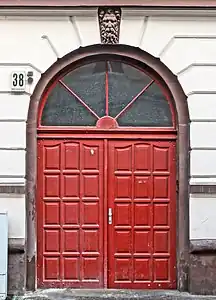 Nr.38 door
Nr.38 door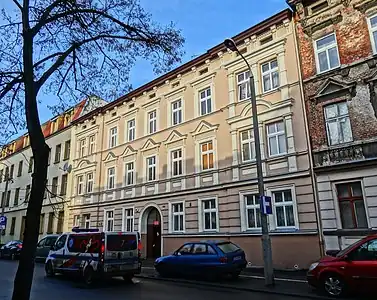 Facade at 40
Facade at 40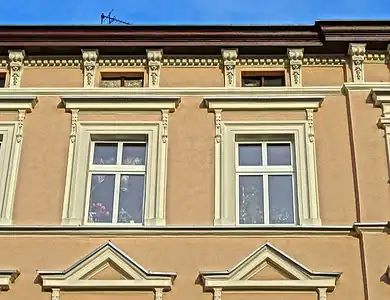 Architectural details at 40
Architectural details at 40
Tenements at 41, 43 and 45
1905[20] (41, 43) 1904[29] (45)
These three tenements at then "13a/13b/13c Brenkenhoff Straße" had been commissionned by the city authorities. In the 1910s, around thirty tenants were living in these city apartments (German: Wohnungsverein).[17]
The U-shape of the building recalls classical architecture patterns, creating an inside courtyard off the street. The renovation performed in the 2010s especially emphasizes the decoration of the portal at Nr.43, with lesenes and vegetal stuccowork.
 View of the three elevations
View of the three elevations
Tenement at 44, corner with 28 Sowińskiego Street
1875–1900[4]
Initial address was "16 Brenkenhoff Straße". Its first registered owner at the beginning of the 20th century was Mr Krüger, who was not living there.[20]
The elevations present a neoclassical style (bossage, pediment and corbel table), the frontage on Sowińskiego street being much longer than the one on Bocianowo street.
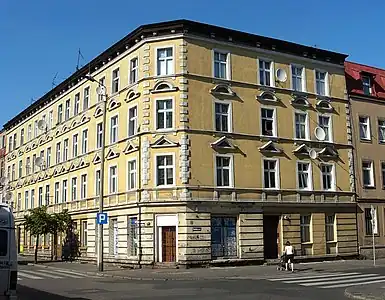 View of the tenement from the street crossing
View of the tenement from the street crossing
Tenements at 49 and 51
1908-1909[30] (49) 1902[28] (45)
The tenement at Nr.49 (then "15 Brenkenhoff Straße") had Jacob Schott as landlord. Owner of the nearby building at 40, he was running a colonial goods shop (German: Kolonialwaren).[30] Nr.51 (then "15a Brenkenhoff Straße"), at the intersection with Sowińskiego street, was first owned by Albin Cohnfeld, a rentier, living at "32 Banhoff straße" (today 77 Dworcowa Street).[16] The following landlord was Konrad Zielsdorf, who had there a restaurant which he operated till the mid-1930s.[31] From 1920 to the start of WWII, two hairdress businesses stood at street level, run by Jan Fritzkowski (Nr.49) and Stanisław Nowakowski (Nr.51).
The facade of Nr.49 keeps only one Art Nouveau element: the floral-motif stucco on the door lintel, bearing the year of erection of the house. The tenement at Nr.51 has only preserved two wrought iron balconies on the corner frontage.
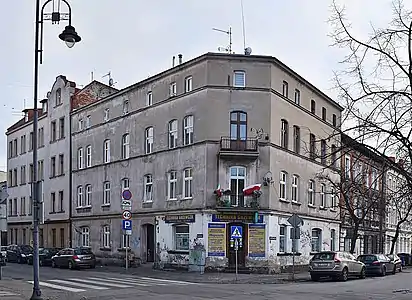 View of both tenements (Nr.49 on the left)
View of both tenements (Nr.49 on the left) Picture of the hairdressing shops ca 1920s
Picture of the hairdressing shops ca 1920s
See also
- Bydgoszcz
- (in Polish) FAMOR company at Kaszubska street
References
- ↑ Paul Berthold Jaekel (1876). Plan der stadt Bromberg [Map of Bromberg city] (Map). 1:5,000 (in German). Bydgoszcz: Paul Berthold Jaekel. Retrieved 1 November 2022.
- 1 2 Czajkowski, Edmund (1989). Nasze Dzielnice Bocianowo. Kalendarz Bydgoski. Bydgoszcz: Towarzystwo Miłośników Miasta Bydgoszczy. pp. 150–151.
- 1 2 J Jablonski (18 February 2005). "Bocianowo". byddzia.pl. byddzia. Archived from the original on 2003-12-02. Retrieved 1 November 2022.
- 1 2 3 4 5 6 7 8 9 10 11 12 13 14 15 16 Zarządzen NR 439/2015 Prezydenta Miasta Bydgoszczy ie Uchwala NR XLI/875/13. Bydgoszcz: Miasta Bydgoszczy. 7 August 2015. pp. 3–4.
- ↑ "Names". Adressbuch nebst allgemeinem Geschäfts-Anzeiger von Bromberg und dessen Vororten auf das Jahr 1882 auf Grund amtlicher und privater Unterlagen. Mittler. 1882. pp. 57, 82.
- 1 2 3 4 bor (1 February 2022). "Bocianowo też staje się coraz ładniejsze. Odnawianie elewacji kamienic trwa". bydgoszcz.wyborcza.pl. Agora SA. Retrieved 1 November 2022.
- ↑ Redakcja (24 March 2013). "Przy placu Kościuszki stoi rzeźba, symbol pobliskiego Famoru. Stoi i niszczeje, jak niejeden pomnik z lat 70". expressbydgoski.pl. Polska Press Sp. z o. o. Retrieved 1 November 2022.
- 1 2 UAF (28 January 2022). "Estetyczne zmiany na ulicy Bocianowo". bydgoszcz.pl. Miasto Bydgoszcz. Retrieved 1 November 2022.
- 1 2 3 "landlords". Książka Adresowa Miasta Bydgoszczy : na rok 1933. Władysław Weber. 1933. pp. 8–9.
- 1 2 3 4 "landlords". Adressbuch nebst allgemeinem Geschäfts-Anzeiger von Bromberg und dessen Vororten auf das Jahr 1899: auf Grund amtlicher und privater Unterlagen. August Dittmann. 1899. pp. 16–17.
- 1 2 "landlords". Adressbuch nebst allgemeinem Geschäfts-Anzeiger von Bromberg und dessen Vororten für 1911: auf Grund amtlicher und privater Unterlagen. August Dittmann. 1911. pp. 86–88.
- 1 2 "landlords". Adressbuch nebst allgemeinem Geschäfts-Anzeiger von Bromberg und dessen Vororten auf das Jahr 1915: auf Grund amtlicher und privater Unterlagen. August Dittmann. 1915. pp. 59–62.
- 1 2 3 4 Adressbuch nebst allgemeinem Geschäfts-Anzeiger von Bromberg und dessen Vororten auf das Jahr 1900: auf Grund amtlicher und privater Unterlagen. Bromberg: August Dittmann. 1900. pp. 10–12, 18, 46, 52, 87, 146, 183, 229.
- 1 2 3 4 Adressbuch nebst allgemeinem Geschäfts-Anzeiger von Bromberg und dessen Vororten auf das Jahr 1880 : auf Grund amtlicher und privater Unterlagen. Bromberg: August Dittmann. 1880. pp. X–XI.
- 1 2 Adressbuch nebst allgemeinem Geschäfts-Anzeiger von Bromberg und dessen Vororten auf das Jahr 1890: auf Grund amtlicher und privater Unterlagen. Bromberg: August Dittmann. 1890. pp. 15–16.
- 1 2 Adressbuch nebst allgemeinem Geschäfts-Anzeiger von Bromberg und dessen Vororten auf das Jahr 1904: auf Grund amtlicher und privater Unterlagen. Bromberg: August Dittmann. 1904. pp. 20–22.
- 1 2 3 4 "landlords". Adressbuch nebst allgemeinem Geschäfts-Anzeiger von Bromberg und dessen Vororten auf das Jahr 1910: auf Grund amtlicher und privater Unterlagen. August Dittmann. 1910. pp. 81–84.
- ↑ Adressbuch nebst allgemeinem Geschäfts-Anzeiger von Bromberg und dessen Vororten auf das Jahr 1906: auf Grund amtlicher und privater Unterlagen. Bromberg: August Dittmann. 1906. pp. 23–25.
- ↑ "landlords". Książka Adresowa Miasta Bydgoszczy : wydana w roku 1926. Władysław Weber. 1926. pp. 15–18.
- 1 2 3 4 "landlords". Adressbuch nebst allgemeinem Geschäfts-Anzeiger von Bromberg und dessen Vororten auf das Jahr 1895 : auf Grund amtlicher und privater Unterlagen. August Dittmann. 1895. pp. 15–16.
- ↑ ts (17 October 2012). "Proszę państwa, oto miś. Kamienicę zdobi dziś". expressbydgoski.pl. Polska Press SP. Z.o.o. Retrieved 1 November 2022.
- ↑ Adressbuch nebst allgemeinem Geschäfts-Anzeiger von Bromberg und dessen Vororten auf das Jahr 1905: auf Grund amtlicher und privater Unterlagen. Bromberg: August Dittmann. 1905. pp. 24–26.
- ↑ asj (17 August 2021). "Bocianowo zyskało świeżo wyremontowaną, efektowną kamienicę". bydgoszcz.wyborcza.pl. Agora SA. Retrieved 2 November 2022.
- 1 2 "landlords". Adressbuch nebst allgemeinem Geschäfts-Anzeiger von Bromberg und dessen Vororten auf das Jahr 1893: auf Grund amtlicher und privater Unterlagen. August Dittmann. 1893. pp. 15–16.
- ↑ Derkowska-Kostkowska, Bogna (1996). Anton Hoffmann - tradycja i profesjonalizm w bydgoskiej architekturze. Kronika Bydgoska XXVI. Bydgoszcz: Towarzystwo Miłosnikow Miasta Bydgoszczy - Bydgoskie Towarzystwo Naukowe. pp. 451–463.
- 1 2 "landlords". Adressbuch nebst allgemeinem Geschäfts-Anzeiger von Bromberg und dessen Vororten auf das Jahr 1896: auf Grund amtlicher und privater Unterlagen. August Dittmann. 1896. pp. 15–16.
- ↑ "landlords". Adressbuch nebst allgemeinem Geschäfts-Anzeiger von Bromberg und dessen Vororten auf das Jahr 1897: auf Grund amtlicher und privater Unterlagen. August Dittmann. 1897. pp. 15–16.
- 1 2 Adressbuch nebst allgemeinem Geschäfts-Anzeiger von Bromberg und dessen Vororten auf das Jahr 1902: auf Grund amtlicher und privater Unterlagen. Bromberg: August Dittmann. 1902. pp. 18–20.
- ↑ "landlords". Adressbuch nebst allgemeinem Geschäfts-Anzeiger von Bromberg und dessen Vororten auf das Jahr 1904: auf Grund amtlicher und privater Unterlagen. August Dittmann. 1904. pp. 20–22.
- 1 2 "landlords". Adressbuch nebst allgemeinem Geschäfts-Anzeiger von Bromberg und dessen Vororten auf das Jahr 1909: auf Grund amtlicher und privater Unterlagen. August Dittmann. 1909. pp. 77–79.
- ↑ "landlords". Księga Adresowa Miasta Bydgoszczy: 1936/37. Jan Miernik. 1937. p. 8.
Bibliography
- Umiński, Janusz (1996). Bydgoszcz. Przewodnik (in Polish). Bydgoszcz: Regionalny Oddział PTTK "Szlak Brdy".
External links
- (in Polish) Bakery at 60 Sienkiewicza Street
